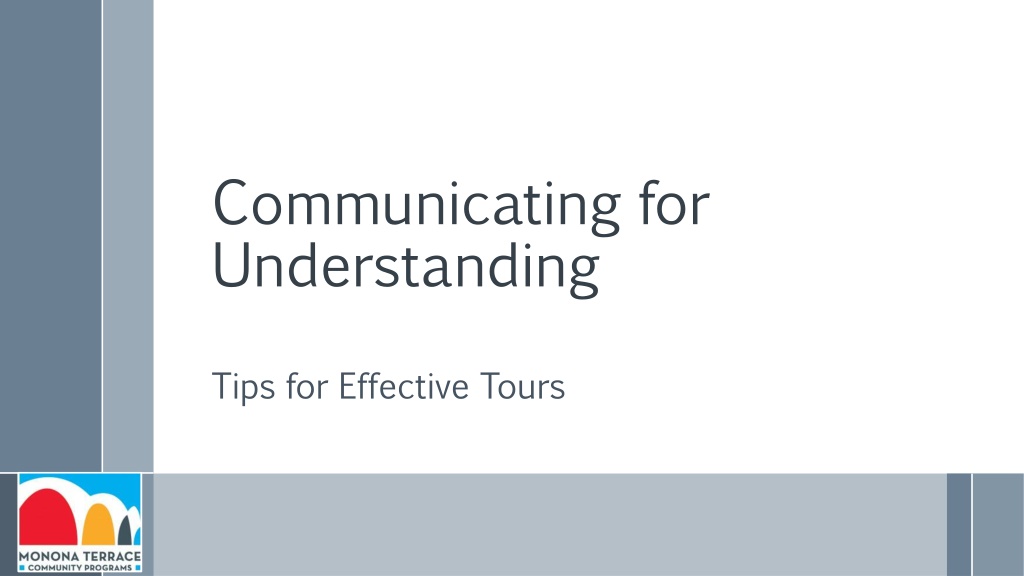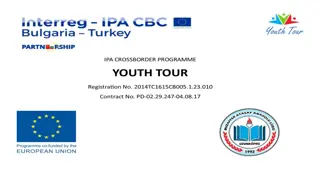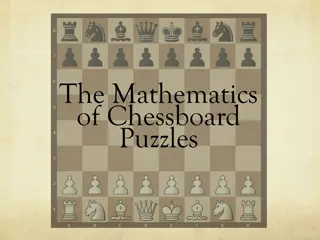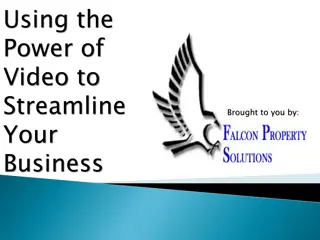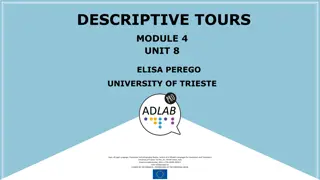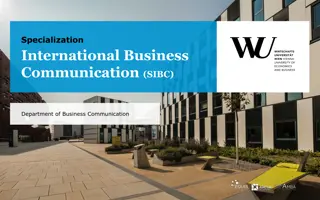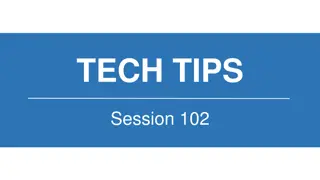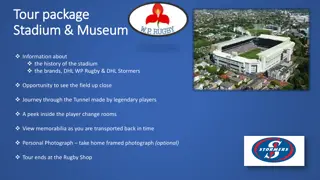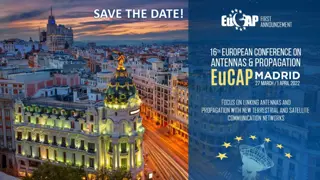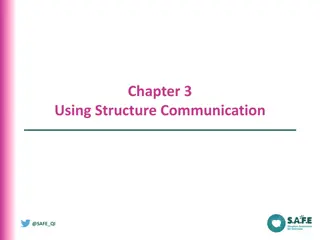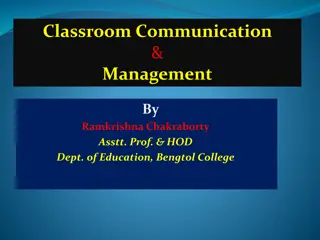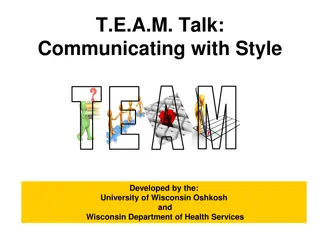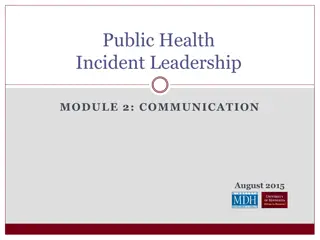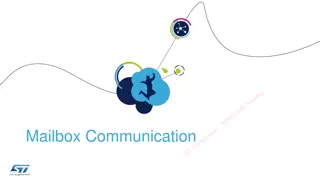Enhancing Communication for Improved Understanding in Tours
Explore strategies to overcome communication barriers and enhance comprehension during tours. Discover tools to simplify information, recognize signs of losing audience interest, and engage them effectively through thought-provoking questions.
Download Presentation

Please find below an Image/Link to download the presentation.
The content on the website is provided AS IS for your information and personal use only. It may not be sold, licensed, or shared on other websites without obtaining consent from the author. Download presentation by click this link. If you encounter any issues during the download, it is possible that the publisher has removed the file from their server.
E N D
Presentation Transcript
Communicating for Understanding Tips for Effective Tours
Communicating for Understanding: Todays Agenda Communicating for Understanding: Today s Agenda Recognizing barriers to effective communication & verifying audience understanding Reducing barriers by simplifying communication and numbers Tools to improve understanding: organizing, previewing, transitions and repetition
Adult Literacy Levels 34-55% of adults are at below basic and basic literacy levels 60% 50% 55% 40% 43% 30% 34% 20% 10% 0% Prose Document Quantitative
Literacy in Wisconsin 1,500,000 Wisconsin adults need literacy services
Those with lower literacy tend to interpret more literally. Piling Saucers Ice wall Pendants Grammar Geometry
Almost everyone will have difficulty with comprehension at some point. It s much harder for those who: Speak English as their second language. Are less educated. Are under great stress.
Barriers to effective communication
Understanding is affected by: Complexity and volume of information Audience listening skills Presenter style and skills
Signs youre losing them Facial expression Head tilts Lack of participation Distracted; focusing on something else No questions
Bringing them back Use questions to focus attention Now, would you like to know how it s possible to grow trees on the roof? Have you wondered how a building is constructed over water? Ask the right questions What questions do you have? Tell me your questions. (NOT) Do you have any questions?
How to know they are understanding
Verify understanding through TeachBack Asking people to repeat in their own words what they need to know or do, in a non- shaming way. NOT a test of the person, but of how well you explained a concept. A chance to check for understanding and, if necessary, re-explain the information.
Verify understanding through TeachBack Ask to demonstrate understanding I ve just given you a lot of information. What is one thing in this room that you found surprising? What will you remember most about this room? Or at the end of the tour This building? I want to be sure I explained everything clearly. How would you say the design of this room illustrates principles frequently used by Frank Lloyd Wright? Do not ask: Do you understand?
Reducing barriers to understanding
Reducing barriers to understanding Make sure you re being heard Avoid background noise Lower pitch of voice (esp. women) Slow down, but not too much
Reducing barriers to understanding Speak clearly and slow down sorrymyemaillookslikethisbutmycomputerdroppedandmyspacebarbroke
Reducing barriers to understanding Slow down
Use plain, simple language 20% of American adults read at or below the 5th grade level.
Use plain, simple language Jargon: An example
Use plain, simple language Using/Avoiding Jargon and Acronyms What are 3 words you use in your tours that might be considered jargon terms or abbreviations that you might commonly use but which might not be familiar to guests?
Use plain, simple language Avoiding or Defining Jargon Curvilinear Organic Architecture Shelter/freedom Compression/Release Breaking the box Harmonious environment Indirect lighting Usonians Froebel blocks Pendants Green purchasing LEED GFRG
Use plain, simple language Use words familiar to visitors Green purchasing Purchasing products with a positive effect on our health and the environment
Use plain, simple language What is a way to say two in plain language? two of these words Pilings Spires Indirect lighting Saucer light Sconces
Use plain, simple language Defining or illustrating terms visitors should know Compression/release Here you see an effect called comprehension/release. You see a lower ceiling when you enter, then a few steps later the ceiling rises dramatically.
Use plain, simple language What is a way to define or illustrate two of these words in plain language? two Organic architecture Curvilinear Pendants Natural materials
Use plain, simple language Use one-idea sentences No: The rooftop garden, which has nearly 11,000 donated tiles, allows public access and community events and was designed to make sure rainwater drains and plants and trees could grow. Yes: The Rooftop Garden was designed for public access and community events. Its unique construction effectively drains rainwater. The structure supports planters for trees and other plants. The floor includes nearly 11,000 donated tiles.
Communicating numbers THERE ARE 3 KINDS OF PEOPLE IN THIS WORLD Those who are good at math and those who are not.
Communicating numbers Pop Quiz Pop Quiz 1. A person entering a contest has a 1% chance of winning. If 1,000 people enter, how many would you expect to win? Answer: 10 Answer: 10 2. A person driving in Madison has a 1 in 1,000 chance of an auto accident. What percent of people driving will have an accident? Answer: 0.1% Answer: 0.1%
Communicating numbers Less is more only relevant information Reduce need for calculations Frequency, not percent Familiar objects as analogies
What analogies could you use? Each piling can support at least 120 tons. There are 352,610 square feet in the building. The building extends 90 feet beyond the shoreline. The Exhibit Hall is 20 feet high.
How can these dates be effectively communicated? 1867 FLW Birth 1909 Nolan City Plan 1911 Taliesin construction began 1954 - City referendum approved 1990 Taliesin Architects consult on convention center 1994 Construction Begins 1997 Monona Terrace Opens
Only need to know concepts= The Big So What? The Big So What? Why should the visitor care about the information you are providing? What does the room or tour station best illustrate? What is not illustrated but still might be pertinent to the space? Put most important information at beginning and end of your presentation of the space.
Ballroom Activity Which of these items would you not include presentation of the Ballrooms? not include in a Activities as a convention center Various lighting examples A feeling of being connected to nature and the outdoors Meeting height limitations by using compact trusswork
Chunking Information Break up material into manageable bite-size chunks Group together related information Limit to 5 pieces of information at a time; 3 even better
Chunking Information Which items would you pair together in your presentation? A. Chandeliers B. Compact trusswork C. Indirect lighting on walls D. Flexible walls E. Types of events we host as a convention center F. Current design is very close in height to Wright s concept
Chunking Information No, this Wright roof doesn t leak! Special precautions were taken to provide rooftop drainage so that the roof will not leak. First, the poured concrete floor slab was sloped for drainage. The workers then prepped the concrete slab with a primer coat. The first and subsequent layers of roofing material is a membrane which is applied with a gas torch by uncoiling the membrane and heating it as it is unrolled: roll it out and torch, roll it out and torch, repeatedly. When heated, this material melts and adheres to the primer coat. Each layer is about 1/8" thick. A second torch-applied layer follows, applied in the same manner as described above overlapping the seams. On the top layer of membrane, a drainage mat is installed which allows the water to run through. A filter fabric is placed on top of the drainage mat to filter out sand and dirt while still allowing water to pass through and drain on the concrete slab below. The next layer is comprised of two layers of 2" thick rigid (very high density) Styrofoam insulation, staggering the joints. On top of the insulation, workers place 4 adjustable pedestals for each tile. The pedestals are leveled and filled with a grout-like substance that acts to stabilize the pedestals so that the Rooftop Garden floor surface (the pavers we stand on) can be level.
Chunking Information No, this Wright roof doesn t leak! We have a sophisticated system of layers that drains water off the roof layers that drains water off the roof. First, the poured concrete floor slab was sloped concrete floor slab was sloped for drainage. Next workers applied several layers of water slab with a gas torch. The membrane is heated so that it melts and sticks. The next step in constructing the roof was to add a drainage mat allows water to run through. A filter fabric filter fabric was installed to filter out sand and dirt. After the fabric, workers added two layers of 2" thick, rigid, very dense Styrofoam insulation Styrofoam insulation. How do we get the rooftop pavers so level? There are 4 adjustable pedestals pedestals for each tile at the corners. The pedestals were leveled and filled with a grout-like substance to stabilize them. sophisticated system of water- -resistant membrane resistant membrane to the drainage mat that 4 adjustable
Preview whats coming up Preview information to let visitors know what s in store. This will better prepare them to understand what you re about to communicate. Examples: Today I m going to share with you how Frank Lloyd Wright changed the way we experience buildings. We ll take a look at specific examples here at Monona Terrace. Now let s move to the Grand Terrace to see how Frank Lloyd Wright connects us with our beautiful natural setting.
Use transitions between topics Use transitions to carry themes through your tour and reinforce main messages. Examples: Earlier I mentioned that one of the three purposes of Monona Terrace is as a community gathering place. The youth dance demonstrations we hold on this Rooftop Garden is a great example. Now as we go indoors, let s take a look at how circular shapes continue be an important part of the design.
Use transitions between topics More examples: Monona Terrace can meet the needs of a variety of different group sizes and events. We just saw how we can serve a small group in the Dane Room, now let s see how we can accommodate conventions and large meetings in the Exhibit Hall. I mentioned that Tony Puttnam had some unique challenges in adapting the design for our contemporary convention center. Here s another example
Repeat key phrases across sentences Examples: Frank Lloyd Wright chose curvilinear color, and building symmetry in homage to the State Capitol. Tony Puttnam continued curvilinear his interior design. Note the circular elements in the ceiling and the carpet. curvilinear forms, exterior curvilinear concepts in
Communicating for Understanding Tips for Effective Tours
